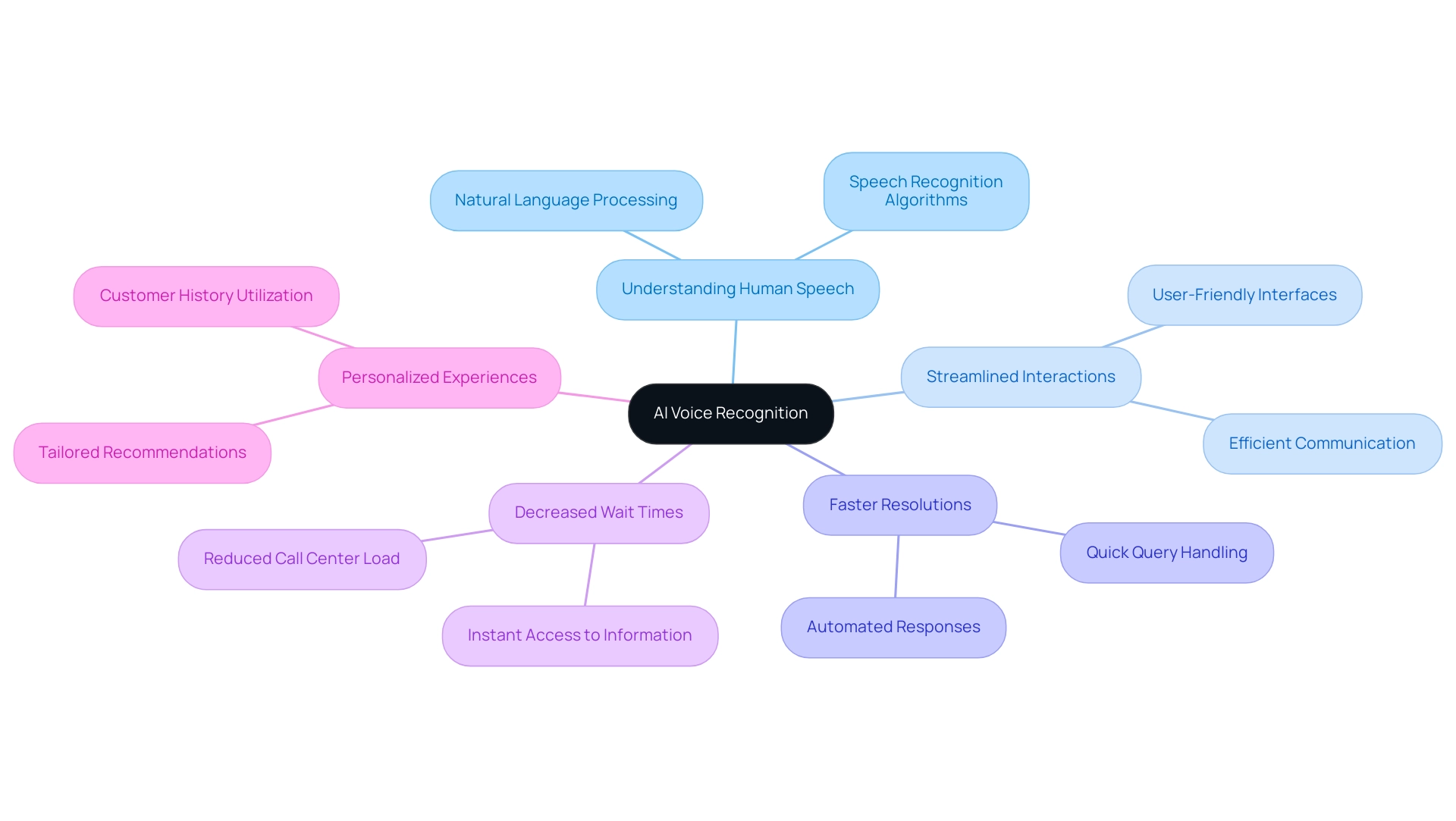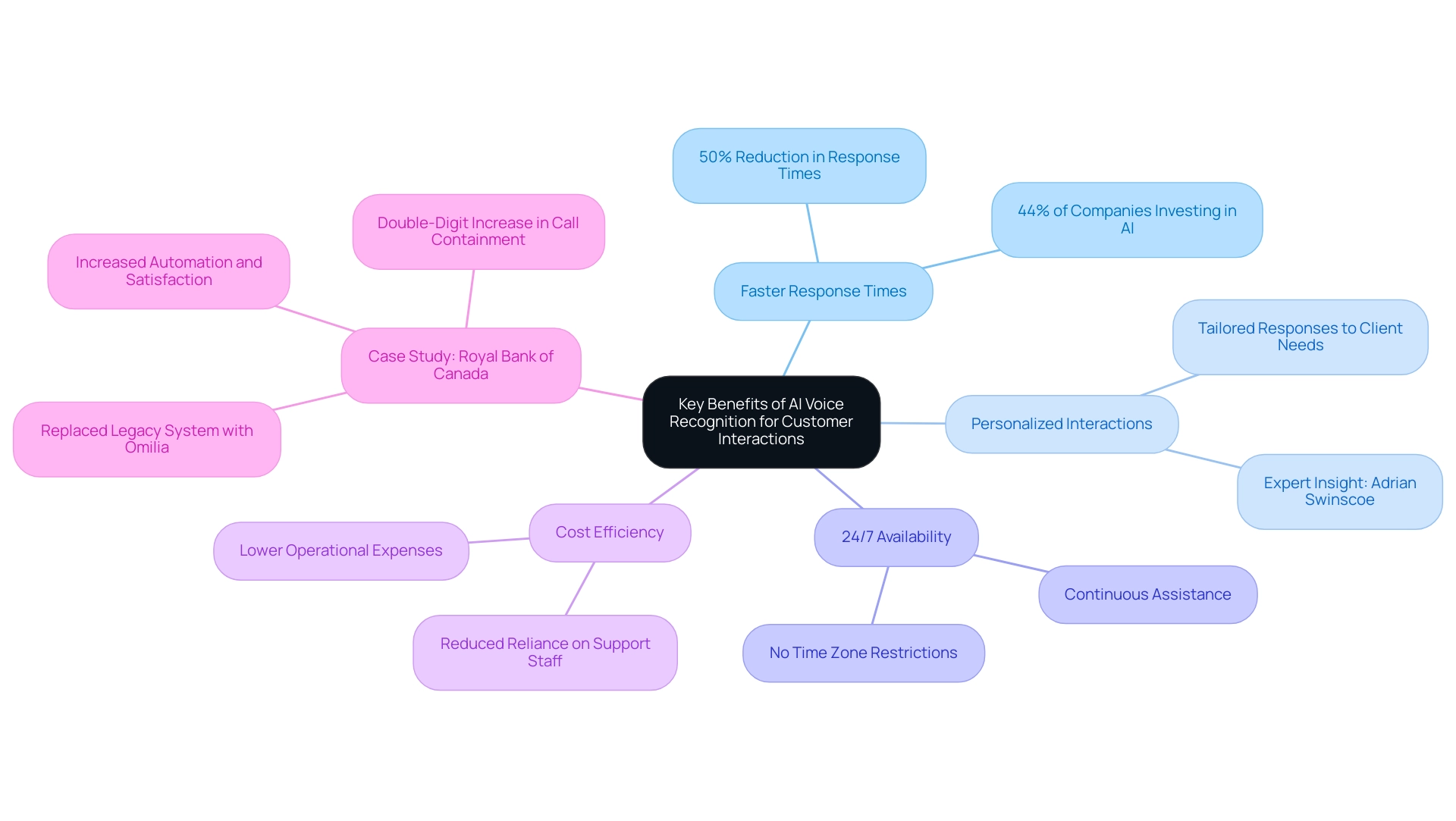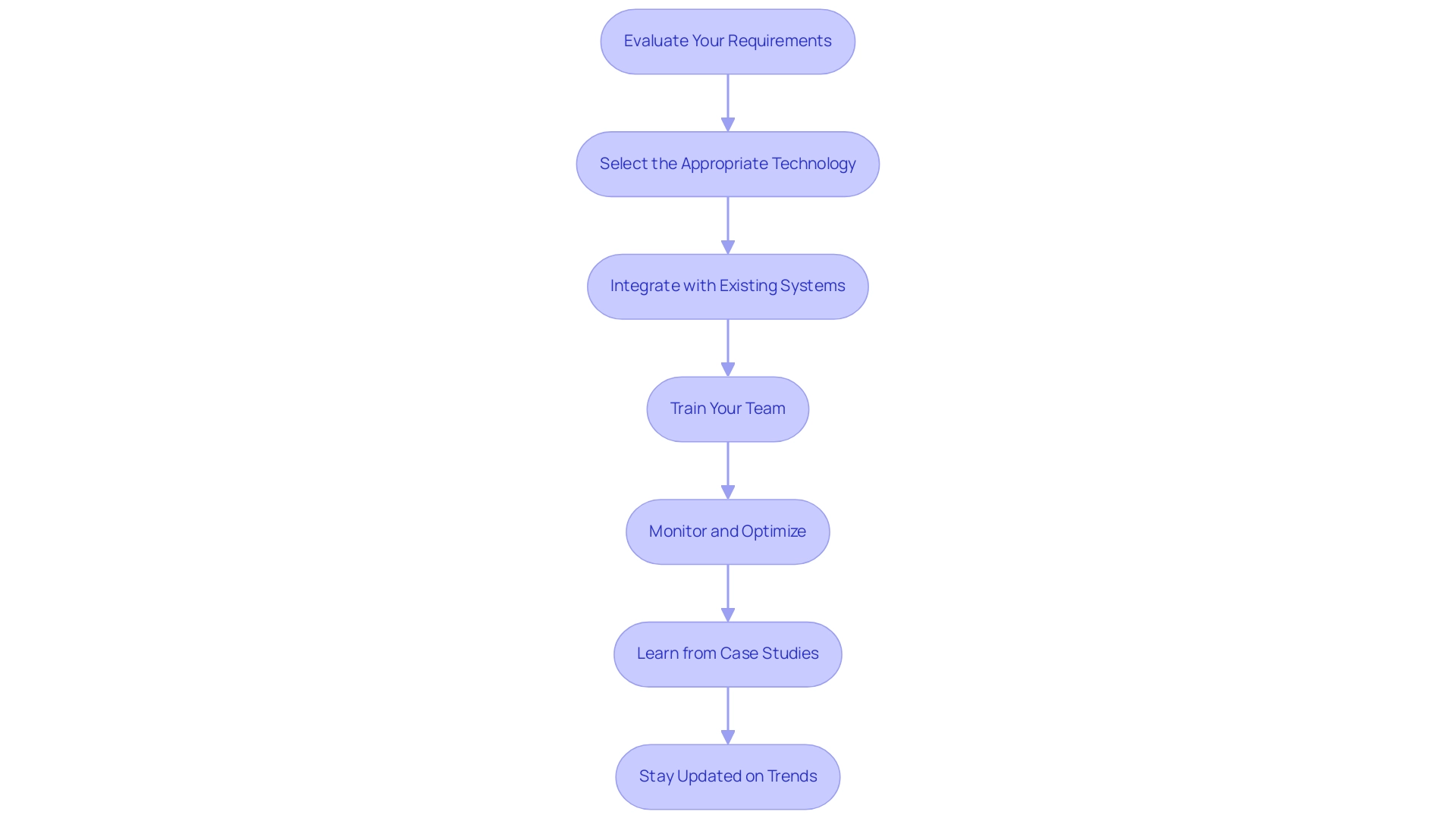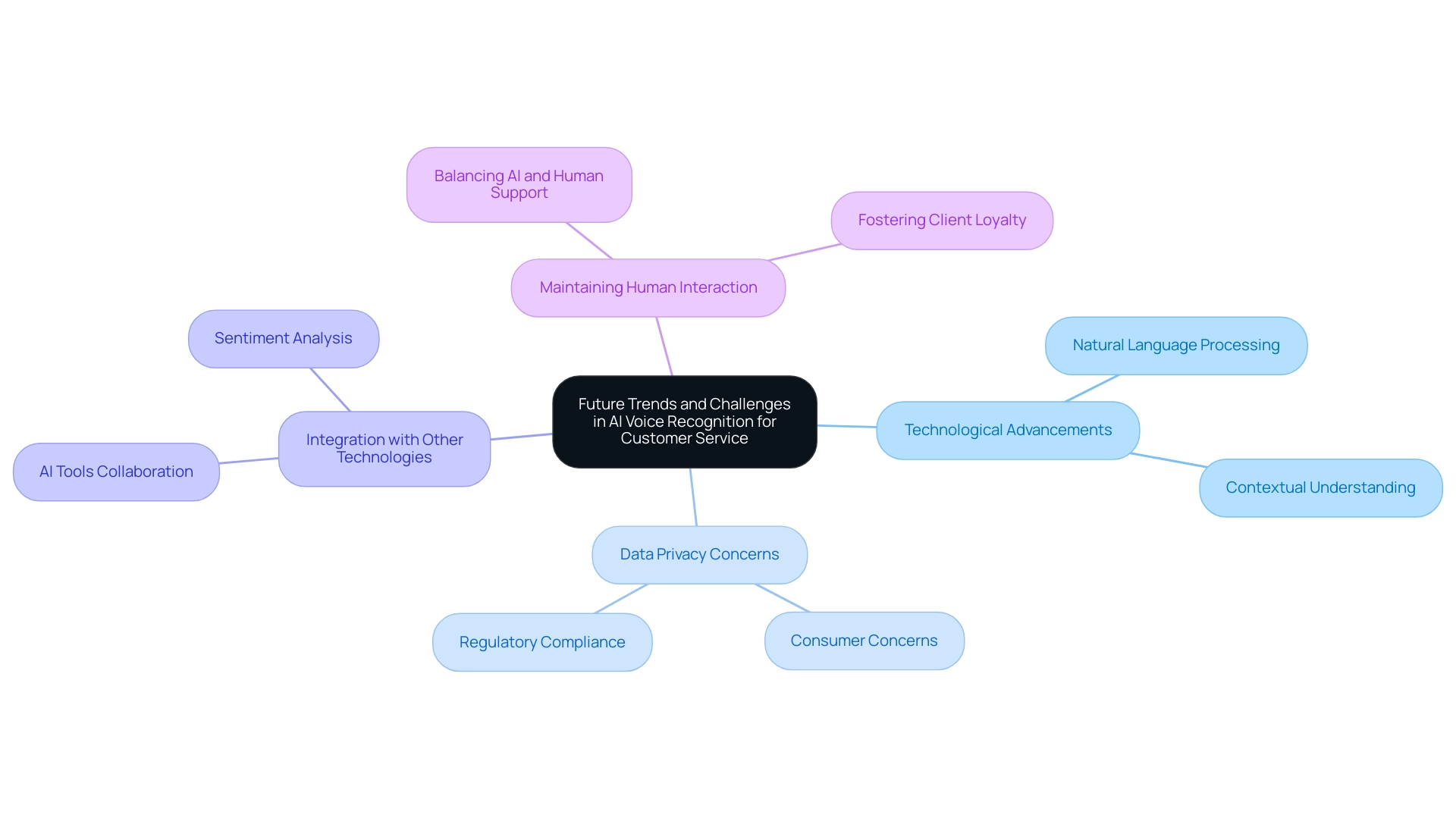Introduction
In an age where customer expectations are at an all-time high, businesses are increasingly turning to AI voice recognition technology as a powerful tool to enhance customer satisfaction. This innovative technology not only streamlines interactions but also personalizes experiences, enabling organizations to respond to inquiries with remarkable speed and efficiency. As companies navigate the complexities of implementing AI solutions, understanding the myriad benefits and future trends of voice recognition becomes essential.
From faster response times to the integration of advanced technologies, this article delves into the transformative impact of AI voice recognition on customer service, providing a roadmap for organizations eager to leverage its potential for improved engagement and loyalty.
Understanding AI Voice Recognition and Its Role in Customer Satisfaction
AI voice recognition systems employ algorithms and machine learning to interpret and respond to human speech. By enabling systems to understand natural language, businesses can streamline interactions, making them more efficient and user-friendly. This innovation plays a crucial role in client satisfaction by enabling faster resolutions to inquiries, decreasing wait times, and offering personalized experiences. Grasping this innovation enables companies to utilize its features efficiently, resulting in enhanced client interaction and loyalty.

Key Benefits of AI Voice Recognition for Customer Interactions
AI audio identification technology provides numerous transformative advantages for client interactions, significantly enhancing the overall service experience.
-
Faster Response Times: AI-powered speech identification systems automate replies, significantly decreasing wait durations for customers. For instance, studies show that organizations implementing AI voice systems have reported up to a 50% reduction in average response times. This illustrates the widespread acknowledgment of their efficiency, especially as 44% of private sector companies plan to invest in AI systems in 2023. Such investments are motivated by the need to enhance productivity and client satisfaction.
-
Personalized Interactions: By identifying individual voices and understanding client preferences, AI voice recognition enables highly personalized interactions. This tailored approach ensures that clients receive responses suited to their specific needs, significantly boosting satisfaction rates. Industry expert Adrian Swinscoe notes, "Embracing Ai's potential allows businesses to revolutionize client experiences and truly engage with their audience." This highlights the significance of innovative solutions in improving client engagement.
-
24/7 Availability: AI systems operate continuously, providing round-the-clock assistance to users. This constant availability ensures that individuals can access assistance whenever they need it, without being restricted by time zones or business hours.
-
Cost Efficiency: Implementing AI speech identification can lead to significant cost savings by decreasing the reliance on a large support staff. These systems maintain high service levels while lowering operational expenses, making them a cost-effective solution for businesses.
The case study of the Royal Bank of Canada exemplifies these benefits. By substituting its legacy contact center system with Omilia's Conversational Virtual Assistant, the bank achieved greater automation, enhanced satisfaction, and a significant rise in call containment, with satisfaction increasing by 20%. Such examples emphasize how AI auditory identification not only improves service quality but also leads to increased retention rates and operational efficiency.

Implementing AI Voice Recognition: A Step-by-Step Approach
To effectively implement AI voice recognition in your customer service operations, follow these expert-recommended steps:
-
Evaluate Your Requirements: Start by pinpointing particular customer interactions that would gain the most from auditory processing advancements. This assessment will help you target high-impact areas and prioritize functionality.
-
Select the Appropriate Technology: Investigate available AI speech processing software to find a solution that aligns with your business goals and budget. The voice recognition market is forecasted to attain 42.08 billion USD by 2029, suggesting a broad spectrum of developing innovations to consider.
-
Integrate with Existing Systems: Ensure seamless incorporation of the selected AI solution with your current service platforms. Compatibility is crucial for maintaining workflow efficiency and minimizing disruptions.
-
Train Your Team: Equip your service representatives with comprehensive training on how to utilize the new tool effectively. According to industry expert Alex Shatalov, 'voice recognition technologies have drastically changed over the years, going from notoriously inaccurate to allowing you to control almost everything in your house.' Proper training will assist your team in utilizing these advancements to enhance client interactions.
-
Monitor and Optimize: After implementation, continuously track performance metrics and collect user feedback. This data-driven method will allow you to fine-tune the system, ensuring it meets client needs and enhances overall service quality.
-
Learn from Case Studies: For instance, Google's Gemini Voice AI has transformed user interaction within the Android ecosystem, streamlining tasks and enhancing overall user experience. Use such case studies to inform your implementation strategies.
-
Stay Updated on Trends: Keep informed about recent trends in AI auditory identification implementation to ensure your business remains competitive and can adapt to new advancements.
Adhering to these steps will lead you through a seamless shift to AI audio processing, ultimately enhancing its advantages for your service operations.

Future Trends and Challenges in AI Voice Recognition for Customer Service
AI auditory recognition systems are progressing swiftly, introducing various significant trends and obstacles to the forefront. Firstly, advancements in natural language processing are set to revolutionize how systems interpret and respond to human speech. Future systems will become increasingly adept at understanding context and nuances, resulting in more effective and seamless customer interactions. A study reveals that nearly three-quarters of device owners already consider them integral to their daily routines, highlighting the growing reliance on this technology.
However, with the increase in audio data usage, data privacy concerns become paramount. According to recent statistics, approximately 70% of consumers express concerns over how their audio data is handled, underscoring the need for businesses to proactively address these privacy issues. Ensuring strict compliance with regulations is essential to protect customer information. This challenge is highlighted by the growing complexity of AI auditory identification systems, which require strong data management protocols.
Integration with other technologies is another key trend. AI voice recognition will operate alongside chatbots and other AI tools, creating a more cohesive and efficient service experience. For example, Amazon Fire TV's voice-activated capabilities can assess sentiment and emotions towards content, showcasing the potential of integrated AI solutions.
Despite the numerous benefits of automation, maintaining the human touch in client interactions remains crucial. Business leaders emphasize that achieving a balance between AI-driven assistance and human support is essential to ensure individuals feel valued and understood. This balance is critical for fostering long-term client loyalty and satisfaction.
By addressing these trends and challenges, businesses can navigate the complexities of AI voice recognition technology in customer service, ultimately enhancing engagement and customer experiences.

Conclusion
AI voice recognition technology is reshaping the landscape of customer service, offering a multitude of benefits that drive enhanced customer satisfaction. By enabling faster response times, personalized interactions, and 24/7 availability, businesses can significantly improve their service delivery, as demonstrated by successful implementations like that of the Royal Bank of Canada. These advancements not only streamline operations but also create a more engaging experience for customers, fostering loyalty and retention.
As organizations embark on the journey of integrating AI voice recognition, a structured approach is essential. From assessing specific needs to ensuring seamless integration with existing systems, every step taken is crucial for maximizing the technology's potential. Continuous monitoring and adaptation to emerging trends will further empower businesses to stay ahead in an increasingly competitive environment.
Looking ahead, the future of AI voice recognition holds great promise, with advancements in natural language processing and integration with other technologies on the horizon. However, addressing data privacy concerns and maintaining the human touch in customer interactions will be paramount. By navigating these challenges effectively, businesses can harness the full power of AI voice recognition, ultimately transforming customer experiences and solidifying their position in the market.





